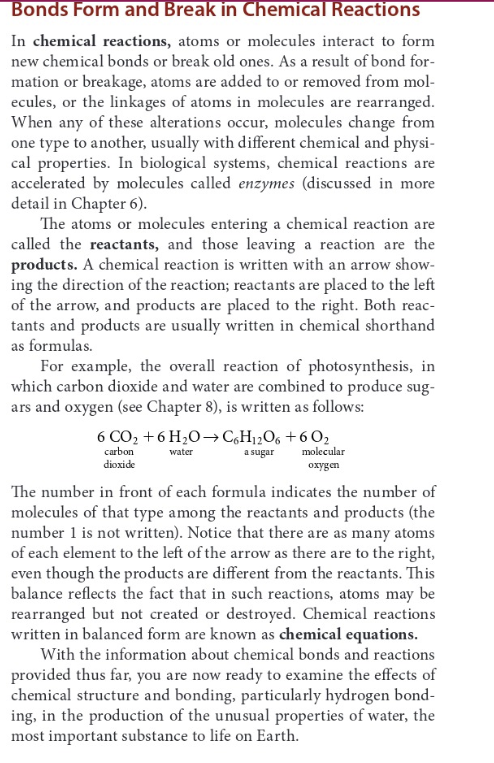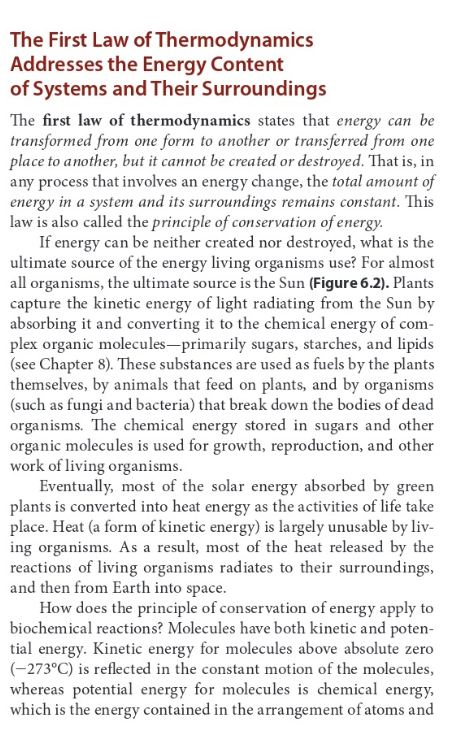Can someone give me an understanding of Products and Reactants? The first image is from the the first chapter where it was introduced under the subject of life, chemistry and water. The second image is on another chapter I am speaks under the subject of Energy, Enzymes and Biological reactions. I can't understand it without the root understanding and application of Products and Reactants.
Can someone give me an understanding of Products and Reactants? The first image is from the the first chapter where it was introduced under the subject of life, chemistry and water. The second image is on another chapter I am speaks under the subject of Energy, Enzymes and Biological reactions. I can't understand it without the root understanding and application of Products and Reactants.
Biology (MindTap Course List)
11th Edition
ISBN:9781337392938
Author:Eldra Solomon, Charles Martin, Diana W. Martin, Linda R. Berg
Publisher:Eldra Solomon, Charles Martin, Diana W. Martin, Linda R. Berg
Chapter3: The Chemistry Of Life: Organic Compounds
Section: Chapter Questions
Problem 1TYU
Related questions
Question
Can someone give me an understanding of Products and Reactants? The first image is from the the first chapter where it was introduced under the subject of life, chemistry and water. The second image is on another chapter I am speaks under the subject of Energy, Enzymes and Biological reactions. I can't understand it without the root understanding and application of Products and Reactants.

Transcribed Image Text:Bonds Form and Break in Chemical Reactions
In chemical reactions, atoms or molecules interact to form
new chemical bonds or break old ones. As a result of bond for-
mation or breakage, atoms are added to or removed from mol-
ecules, or the linkages of atoms in molecules are rearranged.
When any of these alterations occur, molecules change from
one type to another, usually with different chemical and physi-
cal properties. In biological systems, chemical reactions are
accelerated by molecules called enzymes (discussed in more
detail in Chapter 6).
The atoms or molecules entering a chemical reaction are
called the reactants, and those leaving a reaction are the
products. A chemical reaction is written with an arrow show-
ing the direction of the reaction; reactants are placed to the left
of the arrow, and products are placed to the right. Both reac-
tants and products are usually written in chemical shorthand
as formulas.
For example, the overall reaction of photosynthesis, in
which carbon dioxide and water are combined to produce sug-
ars and oxygen (see Chapter 8), is written as follows:
6 CO₂ + 6H₂O → C6H12O6 +60₂
water
a sugar
carbon
dioxide
molecular
oxygen
The number in front of each formula indicates the number of
molecules of that type among the reactants and products (the
number 1 is not written). Notice that there are as many atoms
of each element to the left of the arrow as there are to the right,
even though the products are different from the reactants. This
balance reflects the fact that in such reactions, atoms may be
rearranged but not created or destroyed. Chemical reactions
written in balanced form are known as chemical equations.
With the information about chemical bonds and reactions
provided thus far, you are now ready to examine the effects of
chemical structure and bonding, particularly hydrogen bond-
ing, in the production of the unusual properties of water, the
most important substance to life on Earth.

Transcribed Image Text:The First Law of
Addresses the Energy Content
of Systems and Their Surroundings
Thermodynamics
The first law of thermodynamics states that energy can be
transformed from one form to another or transferred from one
place to another, but it cannot be created or destroyed. That is, in
any process that involves an energy change, the total amount of
energy in a system and its surroundings remains constant. This
law is also called the principle of conservation of energy.
If energy can be neither created nor destroyed, what is the
ultimate source of the energy living organisms use? For almost
all organisms, the ultimate source is the Sun (Figure 6.2). Plants
capture the kinetic energy of light radiating from the Sun by
absorbing it and converting it to the chemical energy of com-
plex organic molecules-primarily sugars, starches, and lipids
(see Chapter 8). These substances are used as fuels by the plants
themselves, by animals that feed on plants, and by organisms
(such as fungi and bacteria) that break down the bodies of dead
organisms. The chemical energy stored in sugars and other
organic molecules is used for growth, reproduction, and other
work of living organisms.
Eventually, most of the solar energy absorbed by green
plants is converted into heat energy as the activities of life take
place. Heat (a form of kinetic energy) is largely unusable by liv-
ing organisms. As a result, most of the heat released by the
reactions of living organisms radiates to their surroundings,
and then from Earth into space.
How does the principle of conservation of energy apply to
biochemical reactions? Molecules have both kinetic and poten-
tial energy. Kinetic energy for molecules above absolute zero
(-273°C) is reflected in the constant motion of the molecules,
whereas potential energy for molecules is chemical energy,
which is the energy contained in the arrangement of atoms and
Expert Solution
This question has been solved!
Explore an expertly crafted, step-by-step solution for a thorough understanding of key concepts.
Step by step
Solved in 2 steps with 1 images

Recommended textbooks for you

Biology (MindTap Course List)
Biology
ISBN:
9781337392938
Author:
Eldra Solomon, Charles Martin, Diana W. Martin, Linda R. Berg
Publisher:
Cengage Learning

Biology: The Unity and Diversity of Life (MindTap…
Biology
ISBN:
9781337408332
Author:
Cecie Starr, Ralph Taggart, Christine Evers, Lisa Starr
Publisher:
Cengage Learning

Anatomy & Physiology
Biology
ISBN:
9781938168130
Author:
Kelly A. Young, James A. Wise, Peter DeSaix, Dean H. Kruse, Brandon Poe, Eddie Johnson, Jody E. Johnson, Oksana Korol, J. Gordon Betts, Mark Womble
Publisher:
OpenStax College

Biology (MindTap Course List)
Biology
ISBN:
9781337392938
Author:
Eldra Solomon, Charles Martin, Diana W. Martin, Linda R. Berg
Publisher:
Cengage Learning

Biology: The Unity and Diversity of Life (MindTap…
Biology
ISBN:
9781337408332
Author:
Cecie Starr, Ralph Taggart, Christine Evers, Lisa Starr
Publisher:
Cengage Learning

Anatomy & Physiology
Biology
ISBN:
9781938168130
Author:
Kelly A. Young, James A. Wise, Peter DeSaix, Dean H. Kruse, Brandon Poe, Eddie Johnson, Jody E. Johnson, Oksana Korol, J. Gordon Betts, Mark Womble
Publisher:
OpenStax College



Biology: The Unity and Diversity of Life (MindTap…
Biology
ISBN:
9781305073951
Author:
Cecie Starr, Ralph Taggart, Christine Evers, Lisa Starr
Publisher:
Cengage Learning